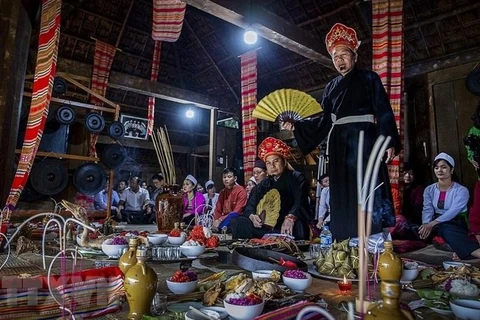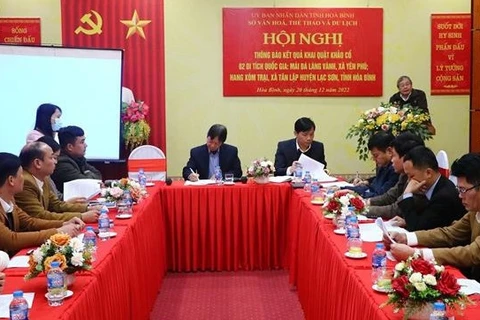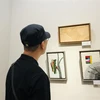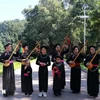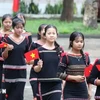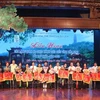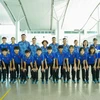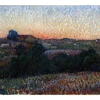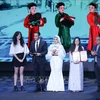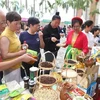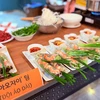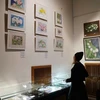 Mo Muong performance and prayers are a unique cultural heritage of the Muong ethnic group who reside in a number of localities. (Photo: VNA)
Mo Muong performance and prayers are a unique cultural heritage of the Muong ethnic group who reside in a number of localities. (Photo: VNA) Hanoi (VNA) - Mo Muong performance and prayers are a unique cultural heritage of the Muong ethnic group who reside in a number of localities.
It is a job and also a performance practiced at funerals, religious festivals, and life cycle rituals by the Muong ethnic group. The art consists of Mo prayers and performances, by Mo practitioners, or Mo artisans.
According to the Department of Cultural Heritage under the Ministry of Culture, Sports and Tourism, Mo Muong heritage originates from provinces and cities such as Hoa Binh, Ninh Binh, Phu Tho, Son La, Thanh Hoa, and Hanoi.
The Ministry of Culture, Sports and Tourism has issued a decision including Mo Muong in Ba Vi, Thach That, Quoc Oai districts of Hanoi city into the list of national cultural heritage.
In Hanoi, only seven Mo artisans are still active, with the oldest 86-year-old Dinh Cong Sinh in Ba Vi district and the youngest 28-year-old Dinh Xuan Nam in Thach That district.
Through generations, Mo prayers are an oral tradition that has been passed down in the community. When they’re collected, translated, and published in books, however, they begin to exist separately from people.
These days, most Mo prayers are called Mo Muong. They are a collection of verses recited at traditional Muong funerals. They are divided into "cat Mo” and "roong Mo”, similar to chapters in literature. Each Mo chapter has its own theme and purposes for each item in a funeral ritual. The chapters may tell folk epics, customs or teach lessons.
Each Muong community has its own version of Mo, but they are all fairly similar. The existence of various versions of Mo has helped expand the heritage and spiritual life of the Muong people.
Mo Muong has a long life, spanning centuries, as it has always helped to nurture the characteristics and the souls of the Muong people.
It is the essence of labour, production, cultural behaviour and the philosophy of the Muong people, reflecting their love of life and home villages.
According to folk cultural specialists, Mo Muong is classified into three categories: Mo Nghi Le (Ceremonial Mo), Mo Ke Chuyen (Story Telling Mo) and Mo Nhom, in which “thay mo” or mo masters play an important role in forming the essence of the unique culture.
Mo Muong bears a set of values expressed in diverse ways, including folk literature: Mo prayers, legends and epics, reflecting the history, lives, customs, beliefs and languages of the Muong people.
The outlook on life: the conceptions on the life of the Muong people, and the geography of where they live.
The worldview: The Muong people’s conception on the universe, which is believed to have three levels and five worlds, as well as the nature of the Muong people.
Folk knowledge: production experience, calendar of events, classification of plants, and experience in dealing with nature.
Space for Mo performance: the traditional funeral of the Muong people and the system of rites, cultural symbol, burial house, and tomb, for the funeral where Mo is performed.
Folk beliefs: the worship of ancestors, the progenitor of Mo, or ritual for living persons, the worship for good luck and peace, worship of plants, sacrifice rites (as seen in Mo buffalo, Mo cow or Mo chicken).
The educational value of Mo Muong remains relevant in life today. It is an oral textbook of historical values passed down from one generation to the next.
The value of cultural protection: Though Vietnam experienced almost 100 years under the domination of French colonialists, foreign faiths could never penetrate the Muong community. Mo Muong helps the Muong people and their culture defend against foreign cultural interference.
In short, Mo Muong is the Muong folk encyclopedia that has been handed down orally through many generations.
According to a survey by the provincial Department of Culture, Sports and Tourism, a total of 23 rituals are performed with this ceremonial singing. The role of “thay mo” is associated with the human life cycle: birth, old age, sickness and death. Prayers are for people’s health, good luck, peace, happiness, and prosperity.
Besides reflecting the unique culture of the Muong people, Mo Muong contains educational value for the community. However, this intangible cultural heritage is in danger of going extinct due to the impact of industrialization and globalization./.
